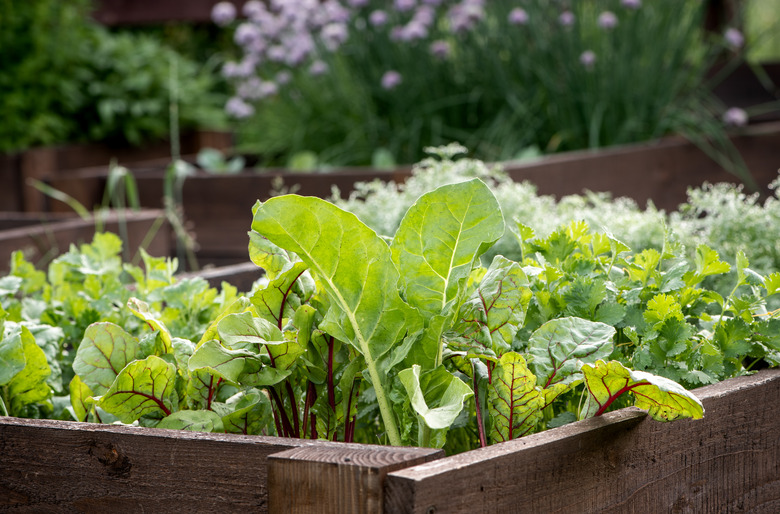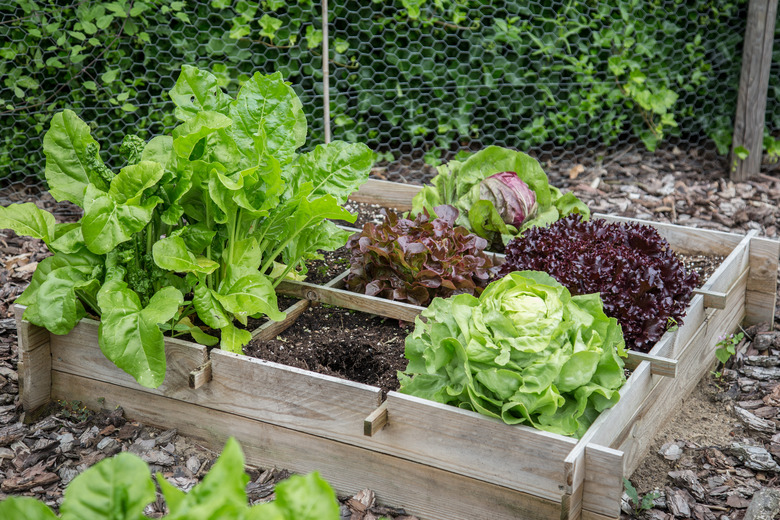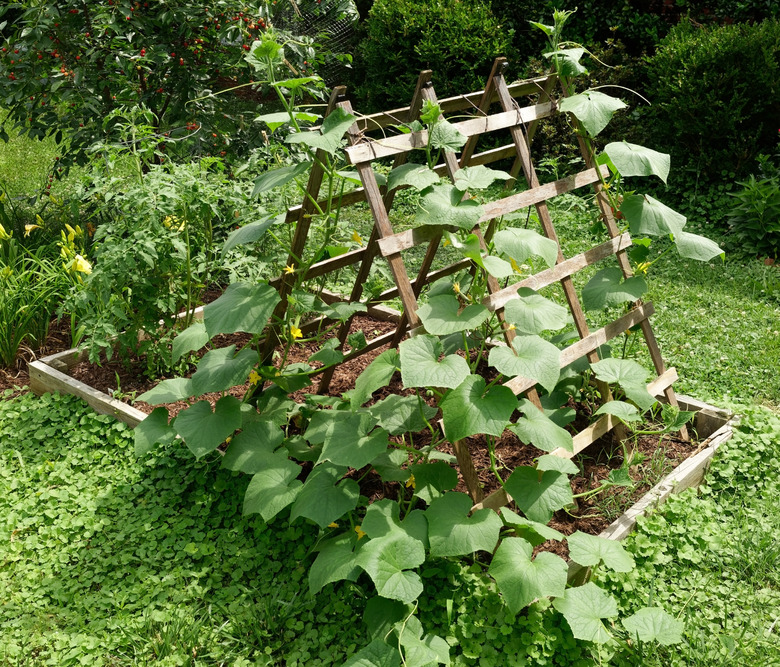Everything You Need To Know About Container Vegetable Gardening
We may receive a commission on purchases made from links.
Container vegetable gardening offers many merits to a home gardener, and in some cases, it's an even better method than traditional in-ground gardening. Traditional vegetable gardening can take up a lot of yard space, and it can be hard work, especially if you have physical limitations. There are numerous reasons container vegetable gardening is a good idea, but there are some things to keep in mind if you practice this very rewarding method.
Advantages of Container Vegetable Gardening
Advantages of Container Vegetable Gardening
In addition to the obvious advantages for gardeners with small spaces or who need the easy accessibility offered by raised containers, there are several other advantages to consider:
- Your in-ground soil may not be ideal for growing vegetables. Most plants prefer a soil pH between 6.0 and 7.0, and if your garden soil happens to be very acidic or alkaline, it can be hard to grow many plants. Using containers lets you create a potting mixture that's perfect for the plants you want to grow. You can even tailor the mix for different plants — more acidic for potatoes (Solanum tuberosum), for example, and more alkaline for lettuce (Lactuca sativa), onions (Allium cepa, zones 5-10) and cucumbers (Cucumis spp.).
- You may have limited sun exposure. In yards that are pretty shady overall, having a vegetable garden in containers makes it possible to move them around to take advantage of shifting sunlight patterns. For example, tomatoes grown in pots need a lot of sun, and a rolling container lets you move it around the patio to keep it in the sun.
- Your garden soil may harbor persistent diseases. Certain fungal and bacterial pathogens, viruses or pests can persist in the soil for many years. Growing in containers with sterilized soil prevents these soilborne pathogens from reaching the plants.
- Container plants are easier to tend. Watering, feeding and weeding are easier tasks in a confined container, which is often raised, so you don't have to stoop as far.
Choosing the Best Vegetables
Choosing the Best Vegetables
Almost any edible plant can be grown in a container provided that the size and depth are right, but some veggies are better suited than others for this type of gardening. Perennial edibles such as asparagus (Asparagus officinalis, zones 3-10), strawberries (Fragaria x ananassa, zones 5-9), artichokes (Cynara cardunculus, zones 7-10), rhubarb (Rheum rhubarbarum, zones 3-8) and some herbs can be tricky to grow in containers, especially in cold climates where exposed containers can freeze so hard that even very hardy perennials have trouble surviving. That's not to say that perennial vegetables can't be grown in containers, but you may need to take special measures to do so.
Vegetables that are quite large are also questionable choices for vegetable container gardening, especially if their production is not prolific. Sweet corn (Zea mays), for example, typically produces only one or two ears per plant, so to get many meals, you need to grow quite a few plants in many containers. Pumpkins (Cucurbita) can send out vines that are up to 20 feet long, so while the plant's roots can certainly be contained within a pot, you have to consider whether there is space for the marauding vines to follow their natural urges.
Great vegetables for container gardening include:
- Beans (Phaseolus vulgaris): Each plant needs pot space about 8 inches wide and 8 inches deep. Pole bean varieties will need a tall, sturdy stake or cage to climb.
- Beets (Beta vulgaris): These grow fast enough that you can plant a second crop after the first has been harvested. Don't forget that the leaves are also edible.
- Chard (Beta vulgaris): The leaves are not only great in salads but they are quite beautiful as container plants. Some gardeners grow chard purely for ornament in mixed containers.
- Greens: A variety of greens, such as collards and kale (both Brassica oleracea), works well in mixed "salad" container gardens. This is true of many leafy vegetables, as they keep producing as you continue harvesting.
- Eggplants (Solanum melongena): These are quite ornamental plants with beautiful, glossy, purplish-black fruits. There are also dwarf cultivars, such as S. melongena 'Hansel' and 'Gretel,' that work well for vegetable container gardening.
- Lettuces (Lactuca sativa): Virtually any type of lettuce works well in a container garden. These shallow-rooted plants are excellent for window boxes.
- Peppers (Capsicum annuum): Peppers of all types make good container plants, as they get by with relatively little water. These are quite attractive plants with nice upright stems.
- Spinach (Spinacia oleracea): These fast-growing plants are great for growing in the cool weeks of spring and fall. In between, your pots can be swapped out to grow a different warm-season vegetable.
- Tomatoes (Lycopersicon esculentum, zones 10-11): Tomatoes will require a large pot and probably a cage to control their branching habit, but this can be one of the best plants to grow in a container. Many varieties will continue to produce fruit all summer long.
- Herbs: Many herbs are excellent choices, especially some varieties of mint (Mentha spp.), which can become invasive if grown in the ground.
Other vegetables that do well in containers include peas (Pisum sativun), potatoes (Solanum tuberosum), squash (Cucurbita spp.) and cucumbers (Cucumis spp.). Some of these will require trellises or extra-large containers for best results. Dwarf vegetable varieties are always worth considering for container gardening.
Choosing Containers for Vegetables
Choosing Containers for Vegetables
There are hundreds of choices when it comes to choosing pots for vegetable container gardening, ranging from large raised-bed planters to tiny clay pots to hold a single herb plant on a deck railing, but the key to growing any vegetable successfully is good potting mix and a container that has good drainage and is made from food-safe material.
Also, tailor the size of the container and its material based on the scale and aesthetics of the space it will occupy. As you do with any flower planter, try to match the style of the vegetable container to the style of your home. A 5-gallon plastic bucket can make a fine tomato planter for a rustic home with a farm-style landscape, but it will look out of place on a patio near roses growing in Chinese ceramic pots.
If you are purchasing a large ornamental container that will remain outdoors year-round, it should be freeze-resistant. Some glazed ceramic or concrete pots will crack, especially if they are left full of saturated soil for the winter. Even standard clay pots may slough and flake if they are left outside through the cold winter months.
Make sure the container has good drainage holes. This can be especially problematic if you are repurposing a metal tub or other metal container; you will need to drill several holes for drainage. Some decorative glazed ceramic pots are more suitable for indoor use since they may have only a single small drainage hole or sometimes no hole at all.
It's a good idea to use pot feet or bricks to elevate the pots slightly so that excess water can flow freely through the drainage holes. A good heavy material will be less likely to blow over in the wind.
Some common materials used for container vegetable gardening have varying advantages and drawbacks:
- Clay terra-cotta is a good material for plants that like dry conditions, as the material is very porous and will "breathe" out moisture rather fast. Some herbs do very well in clay pots, as do peppers. Clay pots work well with almost any garden style.
- Plastic is a very inexpensive, easy-to-clean material, and it holds water better than clay. Plastic pots come in lots of colors and styles; they are good choices for many vegetables. Plastic pots are very light, however, which can make them susceptible to spilling.
- Ceramic pots are made from fired clay with a shiny surface glazing. These retain moisture better than standard clay pots, but they are expensive and may have poor drainage.
- Metal is not a recommended material for vegetables, as it is possible for the metals to leach into the soil and into the plants. They also tend to gradually rust.
- Wood is relatively inexpensive, but it eventually decays. Make sure to avoid pesticide-treated wood; instead, use cedar or redwood containers for edibles.
- Fiberglass and polystyrene foam are relatively new materials that are favorites for highly decorative planters, and they can also work well for container vegetable gardening. They can be quite attractive, but they are also fairly expensive and are so lightweight that they tip rather easily when filled with large plants.
- Repurposed materials are all the rage for container gardening, with objects as diverse as old shoes, 5-gallon plastic buckets, old tires, antique wheelbarrows and even porcelain bathtubs or steel washtubs sometimes used for this purpose. The same guidelines apply to these esoteric objects: Make sure they have good drainage and are made of a food-safe material.
Bigger is usually better when it comes to serious container vegetable gardening. Some authorities suggest that 16- to 24-inch-diameter pots are ideal, and less than 12 inches will not be very suitable except for some small herb plants. Depth will be important for root vegetables, like potatoes and carrots. With very large containers, you may want to mount them on wheels that allow you to move them around on a deck or patio to take advantage of moving sun patterns.
Potting Soil for Container Vegetables
Potting Soil for Container Vegetables
General-purpose potting mix, even though it is sometimes called potting "soil," really has no true soil at all. This type of soilless potting mix is best for growing all potted plants, including most vegetables. You can also save money by making your own potting mix with a mixture of vermiculite, peat moss, powdered limestone, super phosphate (essentially a 0-20-0 granular fertilizer) and general-purpose granular fertilizer (6-12-12 or 5-10-10 formulation).
Soilless mixes are usually based on peat moss, which is moisture-retaining, organic material that also provides some nutrient value. A soilless mix will also be free of weed seeds and pathogens that can multiply uncontrollably if you use ordinary garden soil in your containers.
Whether or not you can reuse the same potting mix year after year or must fill containers with fresh soil every year is a matter of some debate. Some gardeners insist that you must start fresh with new potting mix each year, but plenty of experienced gardeners have great results by simply pouring the old mix into a large mixing container or wheelbarrow, blending in some additional peat moss or compost along with more granular fertilizer and then reusing the mixture when spring planting arrives.
However, if a particular plant suffers some fungal, viral, or bacterial disease or a nematode problem, it's best to discard that potting mix completely and use fresh mix when you next plant in that container.
Training and Supporting Plants
Training and Supporting Plants
Pole beans, cucumbers and any other vining plants will probably need netting or trellises on which to climb. Some gardeners even grow melons trained up trellises in large containers. Sometimes, a single sturdy plant stake is enough; in other cases, a narrow trellis firmly anchored in the pot is the best bet.
Tomatoes, eggplants, peppers and other bushing plants may need cages placed in the pot to provide support for the branches. Such plants need fairly large, heavy pots to make this practical.
Container Vegetable Gardening Tips
Container Vegetable Gardening Tips
Vegetables growing in containers have most of the same cultural needs as they do when planted in the ground when it comes to dealing with pests, diseases and weeds, but there are some aspects that are unique to container vegetable gardening:
- Vegetables growing in containers generally need to be watered more frequently than in-ground plants, especially if they are in pots made of clay or another porous material. Because they are exposed on all sides, they dry out faster than in-ground plants.
- Container-grown vegetables are most susceptible to fast temperature changes. The soil in containers heats up much faster in the sun and will cool down much faster when cold spells hit. This may allow you to plant a little earlier in the spring, but it also means you will need to be alert for unexpected frosts. If you use metal containers, be aware that they can get very hot in the sun very quickly.
- Vegetables growing in pots usually need more fertilizing. This is because the increased watering leaches nutrients from the soil faster. When growing in containers, you should be prepared to fertilize the vegetables at least monthly and possibly weekly for some types. A water-soluble, general-purpose fertilizer is usually the best choice for this.


